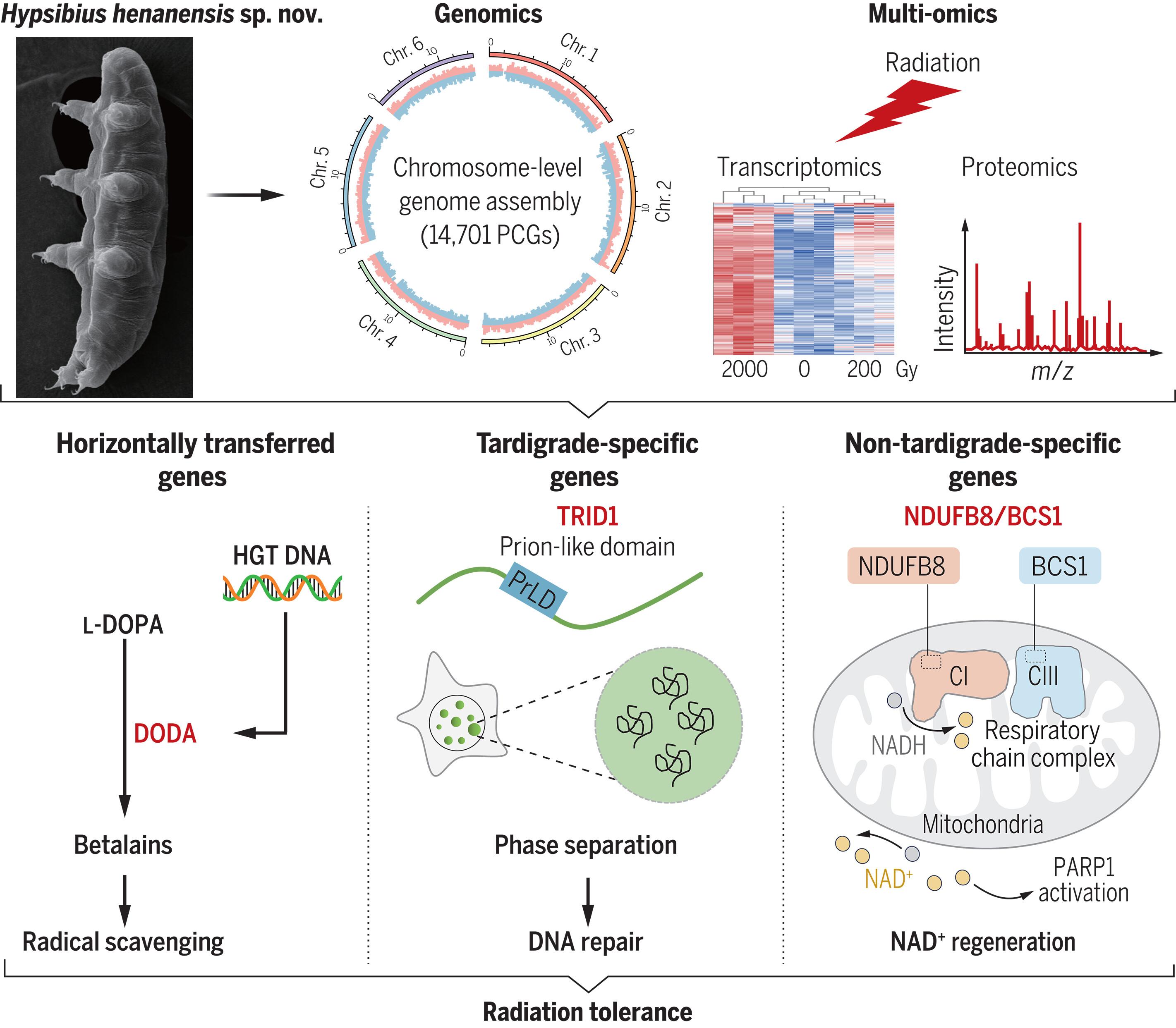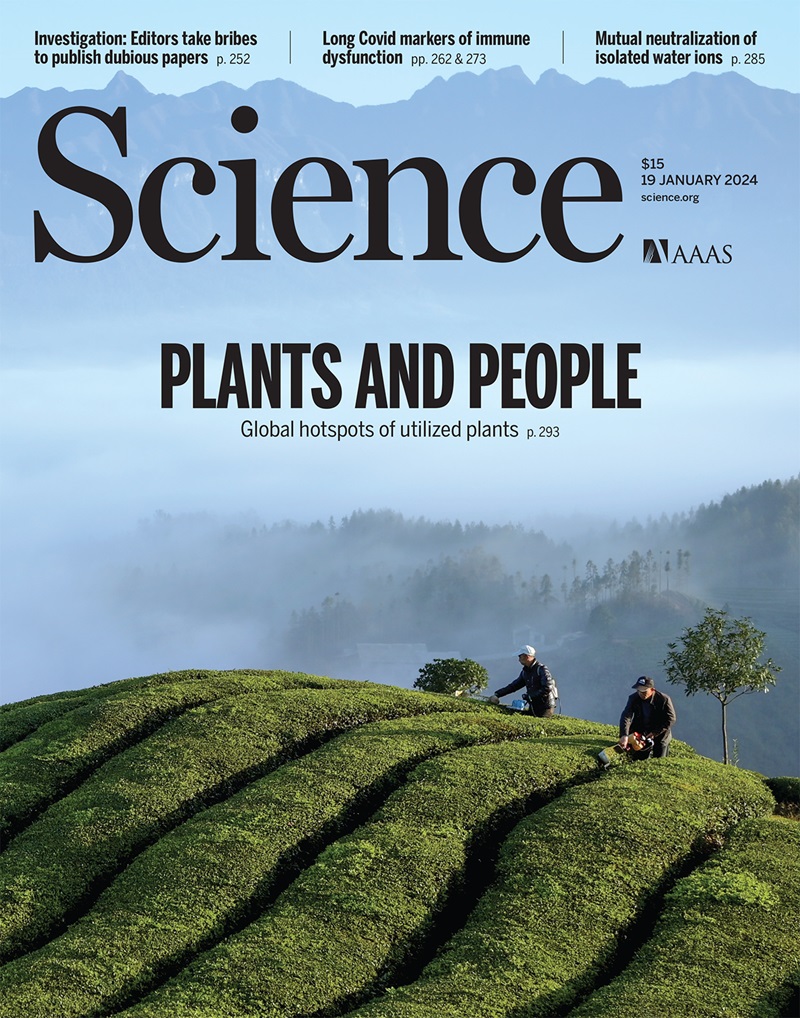Multi-omics landscape and molecular basis of radiation tolerance in a tardigrade
IF 44.7
1区 综合性期刊
Q1 MULTIDISCIPLINARY SCIENCES
引用次数: 0
Abstract
Tardigrades are captivating organisms known for their resilience in extreme environments, including ultra-high-dose radiation, but the underlying mechanisms of this resilience remain largely unknown. Using genome, transcriptome, and proteome analysis of Hypsibius henanensis sp. nov., we explored the molecular basis contributing to radiotolerance in this organism. A putatively horizontally transferred gene, DOPA dioxygenase 1 (DODA1), responds to radiation and confers radiotolerance by synthesizing betalains—a type of plant pigment with free radical–scavenging properties. A tardigrade-specific radiation-induced disordered protein, TRID1, facilitates DNA damage repair through a mechanism involving phase separation. Two mitochondrial respiratory chain complex assembly proteins, BCS1 and NDUFB8, accumulate to accelerate nicotinamide adenine dinucleotide (NAD+) regeneration for poly(adenosine diphosphate–ribosyl)ation (PARylation) and subsequent poly(adenosine diphosphate–ribose) polymerase 1 (PARP1)–mediated DNA damage repair. These three observations expand our understanding of mechanisms of tardigrade radiotolerance.

沙蜥的多组学特征和耐辐射性的分子基础
迟发型生物以其在极端环境(包括超高剂量辐射)中的恢复能力而闻名,但这种恢复能力的内在机制在很大程度上仍然未知。通过对河南痢疾杆菌(Hypsibius henanensis sp. nov.)的基因组、转录组和蛋白质组分析,我们探索了该生物耐辐射的分子基础。一个被认为是水平转移的基因--DOPA二氧酶1(DODA1)--通过合成甜菜碱--一种具有清除自由基特性的植物色素,对辐射做出反应并赋予辐射耐受性。迟发型特异性辐射诱导紊乱蛋白 TRID1 通过一种涉及相分离的机制促进 DNA 损伤修复。两种线粒体呼吸链复合体组装蛋白--BCS1和NDUFB8--的积累加速了烟酰胺腺嘌呤二核苷酸(NAD+)的再生,从而促进了聚(二磷酸腺苷-核糖)化(PARylation)和随后的聚(二磷酸腺苷-核糖)聚合酶1(PARP1)介导的DNA损伤修复。这三个观察结果拓展了我们对尾蜥放射耐受性机制的认识。
本文章由计算机程序翻译,如有差异,请以英文原文为准。
求助全文
约1分钟内获得全文
求助全文
来源期刊

Science
综合性期刊-综合性期刊
CiteScore
61.10
自引率
0.90%
发文量
0
审稿时长
2.1 months
期刊介绍:
Science is a leading outlet for scientific news, commentary, and cutting-edge research. Through its print and online incarnations, Science reaches an estimated worldwide readership of more than one million. Science’s authorship is global too, and its articles consistently rank among the world's most cited research.
Science serves as a forum for discussion of important issues related to the advancement of science by publishing material on which a consensus has been reached as well as including the presentation of minority or conflicting points of view. Accordingly, all articles published in Science—including editorials, news and comment, and book reviews—are signed and reflect the individual views of the authors and not official points of view adopted by AAAS or the institutions with which the authors are affiliated.
Science seeks to publish those papers that are most influential in their fields or across fields and that will significantly advance scientific understanding. Selected papers should present novel and broadly important data, syntheses, or concepts. They should merit recognition by the wider scientific community and general public provided by publication in Science, beyond that provided by specialty journals. Science welcomes submissions from all fields of science and from any source. The editors are committed to the prompt evaluation and publication of submitted papers while upholding high standards that support reproducibility of published research. Science is published weekly; selected papers are published online ahead of print.
 求助内容:
求助内容: 应助结果提醒方式:
应助结果提醒方式:


